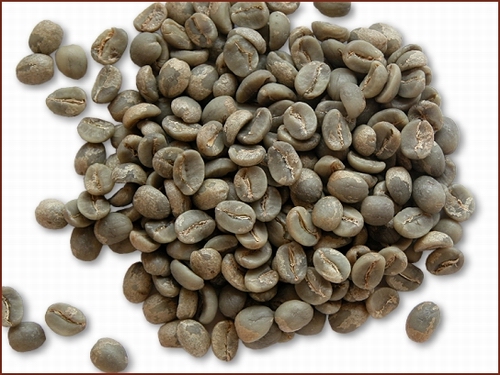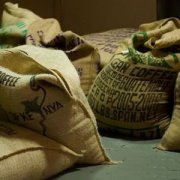How to choose coffee beans

What kind of raw beans are high-quality raw beans? First look at the surface of beans, fresh and high-quality raw beans, the surface is shiny, in addition, the processing of good raw beans, uniform color, the surface of uneven color can not be called good beans, must choose uniform color. Secondly, the particle size is the same, which is also evidence of good quality management. Make sure that the particle size is the same when you buy it. Even and neat coffee raw beans can achieve a consistent baking effect; otherwise, some are too deep and bitter, and some are too shallow and sour, which will affect the overall taste of roasted coffee beans.
Raw beans are divided into several grades according to quality standards, which vary from place to place, basically according to size and shape. The higher the grade, the better the quality. At present, as the domestic coffee raw bean market has just started, the coffee raw beans sold are mainly low-grade futures beans. People usually have a lot of defects in the raw beans they get. Defective coffee beans are quite harmful, including
Mutant bean
It is neither flat bean nor garden bean. Due to abnormal development, the raw bean is broken in the center when shelling. This kind of bean is prone to uneven baking.
Fermented bean / black bean
In the process of processing or washing, the beans are fermented internally. It has the smell of fermented acid.
Unripe beans / white dead beans
Coffee fruits are harvested before they are fully ripe. This kind of bean is ivory after baking and tastes green and astringent.
Moldy bean
The process of processing and transportation is affected by moisture, rain and mold. As long as one bean is moldy, it will soon spread to others, so be careful.
Moth-eaten bean
It is eroded by a pest called coffee bark beetle, and there are worm eyes on the beans, making the coffee smell.
Dried fruit
Bring the outer skin into the drying process. In the non-washing process, the raw beans can be removed from the shell, but in the water washing process, this state becomes defective beans.
Dissimilar bean
For example, robusta mixed with Arabica and flat beans mixed with garden beans.
Small gravel
Easy to break the bean grinder, more extensive sun can be found. When selecting, we spread out the beans and put them in a place with plenty of light, and it is more efficient to pick them with both hands. Basically, coffee raw beans that look uncomfortable can be picked out. After choosing neat beans, the beans can be baked more neatly and tasted more pure. If you mix too many unexpected factors, it is impossible to judge the real taste of the coffee bean itself. General commercial grade of ordinary coffee raw beans, through their own selection, can also reach a very high and expensive level, or even the level of refined coffee.
In terms of variety, not all Arabica beans are selected coffee, only a few high-end beans come from high mountain areas, or after strict selection and classification, they are considered selected coffee because of their hard texture, rich taste and excellent flavor. It only accounts for about 10% of the world's coffee production. As for Robusta beans, all of them have entered the commercial coffee market, and only a few fine beans can be regarded as selected coffee.
From the perspective of coffee treatment: due to the different ripening time of coffee fruit, good coffee must be harvested by hand in 3 to 6 times, and care must be taken in the process of processing, whether it is tanning or washing. The raw coffee beans also have to go through strict selection and classification to ensure the stability of their quality. Although some areas have good local conditions and can produce excellent coffee, they cannot be classified as selected coffee if they are not handled properly or are just leftover inferior products. The American selected Coffee Association has published a selected coffee classification map (Green Coffee Classification Chart), which clearly and fully defines flawless raw beans and coffee with special flavor as selections. The selection of coffee is absolutely special, far exceeding the level that tastes good.
From the perspective of roasting mode, there is a close relationship between the year, type, room temperature, moisture content and baking temperature of raw beans. Generally speaking, the selection of coffee usually uses a small amount of roasting (Small Batch), which must be strictly tested and analyzed in advance, and then be looked after by the roaster until it is in the best condition before it can be stopped. To ensure that the coffee beans can be evenly ripe inside and outside, can ensure the perfect quality.
Select coffee in terms of freshness: fresh coffee is selected coffee, which refers to the freshness of roasted beans, not the freshness of raw beans after harvest. After roasting, the flavor of coffee beans reaches its peak in about 1-7 days, which is the best time to drink; once stored for too long, the coffee will naturally decay and suffer oxidation, and the flavor will not be as good as it used to be.
From the way coffee is sold: it is important that beans are fresh and the roasting date should be kept within 7 days in order to make a good coffee. In contrast, commercial coffee uses iron cans, glass cans or plastic bags to pack poor coffee beans, coffee powder, or instant coffee.
From the trade name of coffee: good coffee has its own characteristics, not willing to be anonymous only called coffee. Therefore, in order to highlight a variety of unique styles, good coffee has its own names, such as Blue Mountain in Jamaica, Yirgacheff in Ethiopia, Sulawesi in Indonesia, Antiqua in Guatemala, Kona in Hawaii and so on. There is also a rating as part of the name, such as: Kenya AA (AA is the highest grade in the local classification system).
Important Notice :
前街咖啡 FrontStreet Coffee has moved to new addredd:
FrontStreet Coffee Address: 315,Donghua East Road,GuangZhou
Tel:020 38364473
- Prev

Coffee development history of Yemeni coffee beans and some African countries
Yemeni coffee bean planting area is also very large, coffee beans occupy an important position in the national economy. Yemeni Matari 999 mocha coffee (Mattar 999) has a unique wild and strong flavor. Yemen, a rather poor region of the Arab countries, was formed in May 1990 by the merger of the Arab Republic of Yemen (Northern Yemen) and the Democratic people's Republic of Yemen (Southern Yemen). Yemenis are used to drinking tea.
- Next

Correct Preservation method of Coffee Bean
The raw beans stored in sacks are very similar to people in many places, such as the storage environment, the comfortable environment is suitable for raw beans: dry, dry, cool, not hot or cold, the only exception is light. Raw beans should be protected from light. Raw beans are crops and need to breathe, so theoretically the best storage material is clean, odorless and breathable.
Related
- Detailed explanation of Jadeite planting Land in Panamanian Jadeite Manor introduction to the grading system of Jadeite competitive bidding, Red bid, Green bid and Rose Summer
- Story of Coffee planting in Brenka region of Costa Rica Stonehenge Manor anaerobic heavy honey treatment of flavor mouth
- What's on the barrel of Blue Mountain Coffee beans?
- Can American coffee also pull flowers? How to use hot American style to pull out a good-looking pattern?
- Can you make a cold extract with coffee beans? What is the right proportion for cold-extracted coffee formula?
- Indonesian PWN Gold Mandrine Coffee Origin Features Flavor How to Chong? Mandolin coffee is American.
- A brief introduction to the flavor characteristics of Brazilian yellow bourbon coffee beans
- What is the effect of different water quality on the flavor of cold-extracted coffee? What kind of water is best for brewing coffee?
- Why do you think of Rose Summer whenever you mention Panamanian coffee?
- Introduction to the characteristics of authentic blue mountain coffee bean producing areas? What is the CIB Coffee Authority in Jamaica?

